Nebulae: The Stunning Celestial Artwork of the Cosmos
Nebulae have long captured the fascination and imagination of humans. These stunning celestial formations, often referred to as the “artwork of the cosmos,” are some of the most beautiful and awe-inspiring sights in the universe.
Nebulae are massive clouds of dust, hydrogen, helium, and other gases that exist in outer space. They are formed from the remnants of dying stars, as well as from the birth of new stars. These clouds can stretch for hundreds of light-years and come in a variety of shapes and colors.
One of the most well-known types of nebulae is the planetary nebula. Despite its name, these nebulae have nothing to do with planets. Instead, they are the remnants of a dying star that has shed its outer layers and created a beautiful, glowing shell of gas and dust. The famous Ring Nebula, located in the constellation Lyra, is a perfect example of a planetary nebula.
Another type of nebula is the emission nebula, which is a cloud of ionized gas that emits light of various colors. These nebulae are often found in regions of space where new stars are being born, and their vibrant colors are created by the interaction of the gas with the intense radiation from nearby stars. The Orion Nebula, located in the constellation Orion, is one of the most famous emission nebulae in the night sky.
There are also reflection nebulae, which are clouds of interstellar dust that reflect the light of nearby stars. These nebulae often appear blue in color due to the scattering of light by the dust particles. The Pleiades star cluster, also known as the Seven Sisters, is surrounded by a stunning reflection nebula that enhances the beauty of this famous group of stars.
Nebulae are not only visually stunning, but they also play a crucial role in the formation and evolution of stars and galaxies. They serve as the birthplace of new stars, providing the raw materials needed for their formation. As stars age and die, they release their outer layers into space, enriching the surrounding nebulae with heavy elements that will eventually be incorporated into new stars and planets.
Thanks to advances in technology, astronomers are now able to study nebulae in greater detail than ever before. Telescopes like the Hubble Space Telescope have provided us with breathtaking images of these cosmic wonders, revealing the intricate structures and vibrant colors that make nebulae such a captivating sight.
Whether you are a seasoned astronomer or simply someone who appreciates the beauty of the night sky, nebulae are a reminder of the vast and wondrous universe in which we live. Their stunning colors and shapes serve as a reminder of the incredible beauty and complexity of the cosmos, inspiring wonder and awe in all who gaze upon them.













